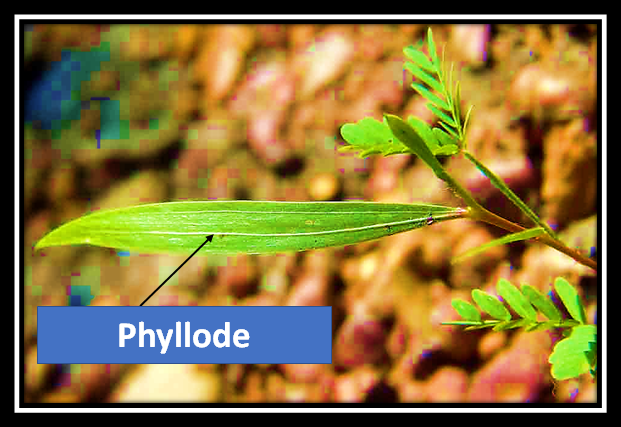
A modification of leaf is _____________.
(a)Phyllode
(b)Phylloclade
(c)Cladode
(d)Corm
Answer
573.6k+ views
Hint: This modification is presented in parts by the plants belonging to the genus Daviesia, in the family Fabaceae. It is defined as a flattened petiole or leaf rachis, resembling and functioning as a leaf.
Complete answer:
A modification of the leaf is phyllode. Let's begin with different modifications of leaves.
The whole leaf or part of it is often modified for performing special functions such as climbing and substrate attachment, protection against predation or climatic conditions, storage or trapping and digesting insect prey. Different leaf modifications are buds, scales, stipules, spines, phyllodes, tendrils, etc.
Now let's study in detail about phyllode.
Modified petioles of leaves stems are called ‘phyllodes.’ They appear like a leaf and also function like one. In some plants, they may become widened and flattened while the leaf itself becomes reduced or disappears altogether. Phyllode serves the purpose of a leaf. An example of a plant showing phyllode is euphoria roylena. Here the phyllode is cylindrical. Another example is opuntia where it is flattened. Such types of modifications are common in the genus Acacia and among them, especially in the Australian species.
Additional Information: The corm is also called bulbotuber. It is a vertical but short swollen underground plant stem. It performs the function of a storage organ for some plants which use it to survive winters or other adverse conditions such as summer drought and heat.
So, the correct answer is, ‘Phyllode.’
Note: -Cladodes and phylloclades are photosynthetic shoots. These are flattened and are usually considered to be modified branches.
-Phylloclades show nodes on them from where the leaves and branches may emerge while cladodes exhibit internodes.
-A corm may have one or more internodes with at least one growing point. This growing point is covered with protective leaves modified into skins or tunics.

Complete answer:
A modification of the leaf is phyllode. Let's begin with different modifications of leaves.
The whole leaf or part of it is often modified for performing special functions such as climbing and substrate attachment, protection against predation or climatic conditions, storage or trapping and digesting insect prey. Different leaf modifications are buds, scales, stipules, spines, phyllodes, tendrils, etc.
Now let's study in detail about phyllode.
Modified petioles of leaves stems are called ‘phyllodes.’ They appear like a leaf and also function like one. In some plants, they may become widened and flattened while the leaf itself becomes reduced or disappears altogether. Phyllode serves the purpose of a leaf. An example of a plant showing phyllode is euphoria roylena. Here the phyllode is cylindrical. Another example is opuntia where it is flattened. Such types of modifications are common in the genus Acacia and among them, especially in the Australian species.
Additional Information: The corm is also called bulbotuber. It is a vertical but short swollen underground plant stem. It performs the function of a storage organ for some plants which use it to survive winters or other adverse conditions such as summer drought and heat.
So, the correct answer is, ‘Phyllode.’
Note: -Cladodes and phylloclades are photosynthetic shoots. These are flattened and are usually considered to be modified branches.
-Phylloclades show nodes on them from where the leaves and branches may emerge while cladodes exhibit internodes.
-A corm may have one or more internodes with at least one growing point. This growing point is covered with protective leaves modified into skins or tunics.

Recently Updated Pages
Why are manures considered better than fertilizers class 11 biology CBSE

Find the coordinates of the midpoint of the line segment class 11 maths CBSE

Distinguish between static friction limiting friction class 11 physics CBSE

The Chairman of the constituent Assembly was A Jawaharlal class 11 social science CBSE

The first National Commission on Labour NCL submitted class 11 social science CBSE

Number of all subshell of n + l 7 is A 4 B 5 C 6 D class 11 chemistry CBSE

Trending doubts
10 examples of friction in our daily life

One Metric ton is equal to kg A 10000 B 1000 C 100 class 11 physics CBSE

Difference Between Prokaryotic Cells and Eukaryotic Cells

1 Quintal is equal to a 110 kg b 10 kg c 100kg d 1000 class 11 physics CBSE

State the laws of reflection of light

Explain zero factorial class 11 maths CBSE




